Cheetahs form part of the ‘super-seven’ (the big-five animals plus wild dogs and cheetahs). These are the animals most people would like to see on safari as they are dangerous and/or exciting to watch.
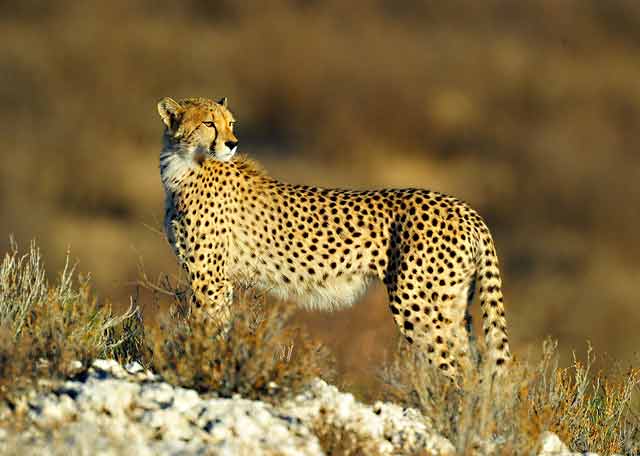
To successfully photograph cheetahs you need to be able to find them, you need to understand a bit of their behavior so you can anticipate the action, and then you need to have at least a DSLR camera with a telephoto zoom lens and know how to use them.
Cheetahs can be found in most African national parks, but the parks that provide the best opportunities tend to be in east Africa (Serengeti in Tanzania / Masai Mara in Kenya) and southern Africa. Safaris in east Africa can be very expensive so this article will focus on the southern African parks of Kruger National Park, Kgalagadi Transfrontier Park and the Pilanesberg National Park in South Africa and Etosha National Park in Namibia – budget conscious parks that offer the choices of guided or self-drive safaris and camps.
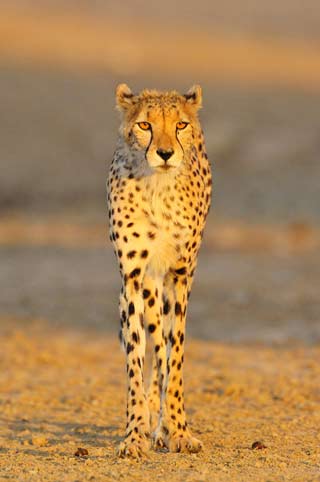
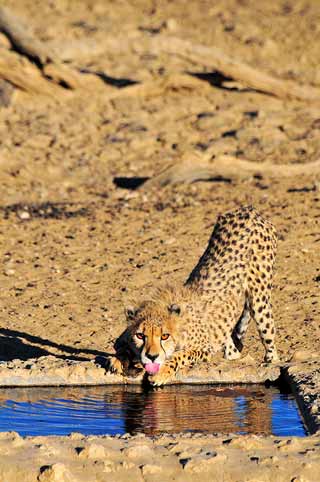
ABOUT CHEETAHS:
Cheetahs are the least dangerous of the big cats – I don’t think I have ever read of a cheetah killing a human, but that does not mean you can get out your car to photograph it when you see one! They are also the least adaptive of the big cats and their habitat is shrinking every year – many farmers shoot them if they break out of a national park. They are therefore listed on the IUCN list of threatened species as vulnerable or critically endangered, depending on which part of Africa they inhabit.
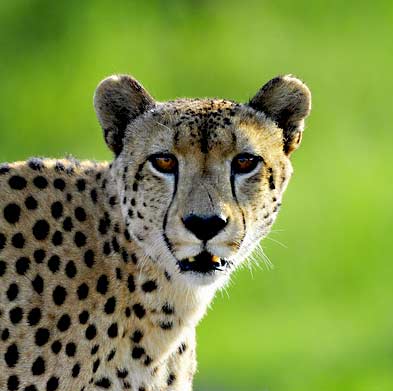
The leopard is called the elusive cat, but the cheetah can often be the biggest contender for this title! They are most active by day but they are the least numerous of the big cats, so sightings of them tend to be rare. The Kruger Park, for example, has about 200 cheetahs compared with about 2000 lions. The best place to see cheetahs is the Kgalagadi Transfrontier Park.
Cheetahs most often drink early in the mornings, so this time of day can provide good photo opportunities.
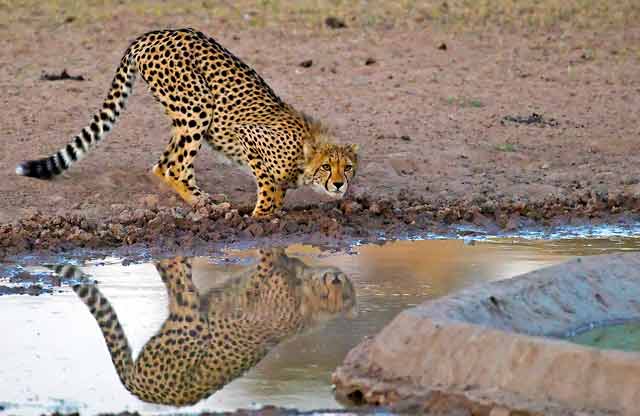
Cheetahs are unable to retract their claws – this helps them when they are chasing prey. They also use their tails like a rudder to help them stay balanced in a chase as they zigzag across the plains. They are not loud animals, but make a soft bird–like chirp or whistle to call or communicate with one another.
The cheetah, having a slender build, is the fastest land animal in the world. They are built for speed and with their long legs, small head and light-weight bones they can reach speeds of over 100km (62 miles) per hour in short bursts.
If you come across more than one adult Cheetah they will most likely be brothers – they often stay together so they can hunt larger prey. The females tend to be solitary cats, except when they have young cubs.
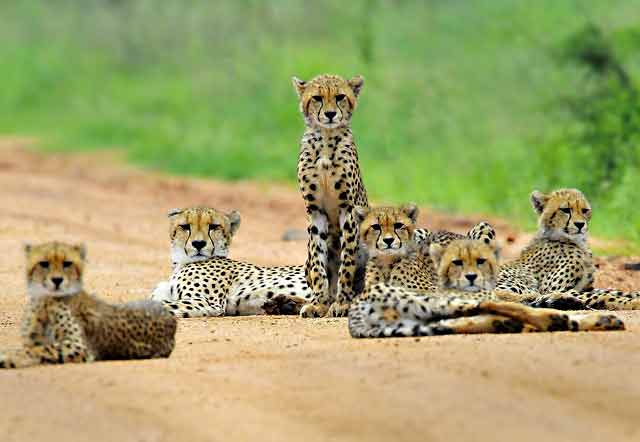
With Cheetahs being lightweight predators they usually go for the smaller antelope such as springbok, impala, young wildebeest or zebras. They will hunt all throughout the day, but most often at midday when it is less likely for a lion to steal their kill.
Cheetahs prefer to hunt on the open plains; because of their speed they need the uncluttered landscape. This is great for photographers. You can get a nice clear photo of a full-on sprint depending which park you’re visiting. The possibilities of photographing this action can be had in both the Kalahari and the lower Nossob area.
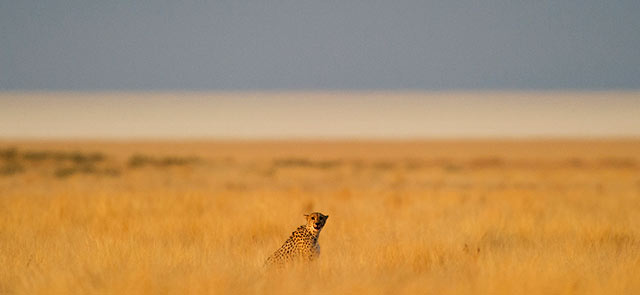
The challenge comes when trying to get those kinds of images in the Kruger with the dense bush, but it is doable. If you know where to find them, then you have won half the battle.
Watching and photographing a Cheetah stalking its pray for more than three hours in the midday summer sun can be torture, but it is worth every minute once you have the photographs!
It’s both amazing and a challenge to watch a cheetah move about and stalk its prey. It will go from tree to tree very slowly or maybe disappear behind a dune or bush and then reappear. And while you are watching it, at the same time, you need to try to stick to the target its approaching, so you’re ready to capture the action. Sometimes you’ll get lucky and be in the right place at the right time, while other times you’ll have to move the vehicle to try to get into position.
Keeping up with the chasing is another challenge. The Cheetah is so fast that you will need to be one step ahead and have the correct camera settings – a fast shutter speed of at least 1/2000 second to freeze the motion and an aperture of around f/8 to ensure enough depth of field for the moving subjects. If you are hand holding, then put your VR / IS on to compensate for your movements. I would suggest zooming out for the chase as you do not want half a cheetah in your photograph – rather have the full chase with dust and all. This is what will give your photos impact.
The killing is always the hardest to photograph because it is always such a power struggle with the prey on the losing end….most times. The killer bite to the throat kills the prey within minutes.
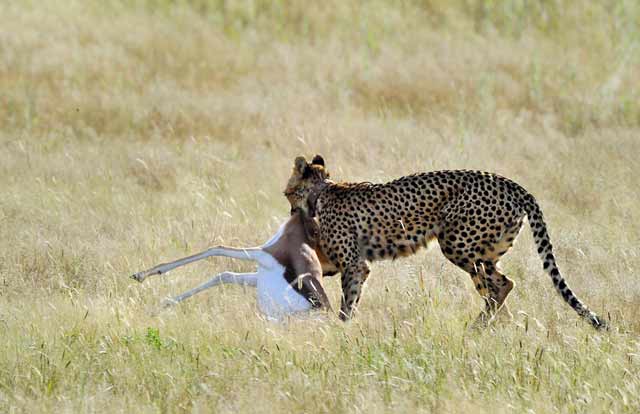
After the kill it’s still not over, as the Cheetah has to catch its breath and cool down. Then it drags the carcass to a spot where it can eat in peace – usually under a tree or bush. This is your chance to get some really great images, but the shadows create a photographic challenge. If you’re close enough, you may have to use your flash.
Another option for the chase is to use a slow shutter speed, around 1/30 second and to pan with the cheetah – this can provide a pleasing motion blur.
Cheetah mothers have two to five cubs in a litter. While she is hunting, she will hide them in the long grass or thick bush. Once she has made the kill, she will call her cubs and take them to eat. It’s now that you may have other great action photo opportunities, from the mother and cubs interacting to the cubs playing and chasing each other.
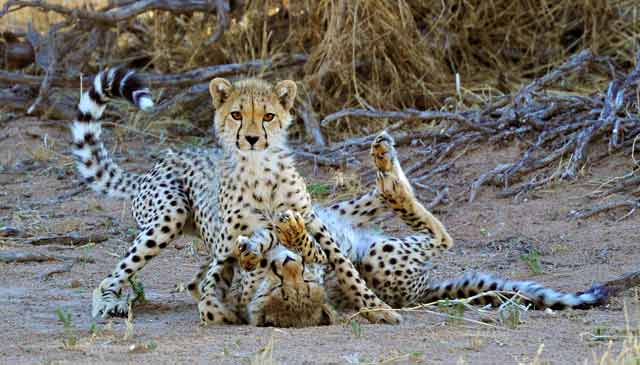
Cheetahs like climbing up onto a vantage-points, like a termite mound, road sign or a fallen tree so they can survey their surroundings. They also spray these areas with urine to mark their territory. If you find a Cheetah near a vantage point, stay with it. You may get some great action photos of it jumping up onto or off the object.
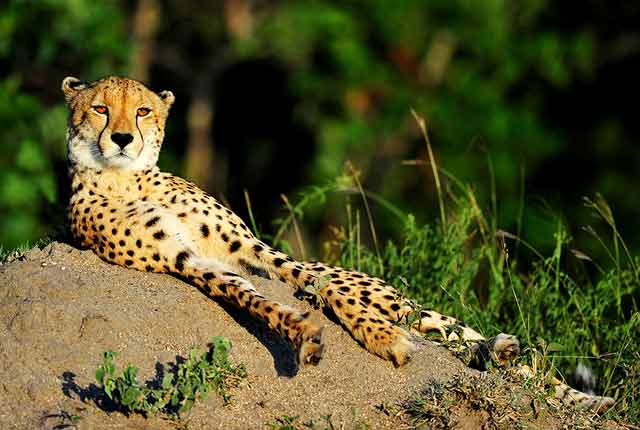
WHAT PHOTO GEAR IS NEEDED?
Most of your cheetah images will be made with a telephoto lens, such as the an 80-400mm, 200-400mm f4, 80-200mm f2.8, and 600mm f4 lenses. Whether you are on a guided or self-drive safari, you will be able to get close enough to the animals – within 50 meter (approx. 50 yards) from the vehicle.
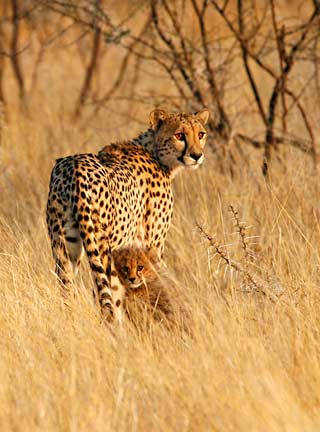
Cheetah and Young Cub in Etosha
Canon 30D with Sigma 120-400mm lens @ 400mm on beanbag, ISO 400, f/8 @ 1/500 sec.
(Image by Kathryn Haylett)
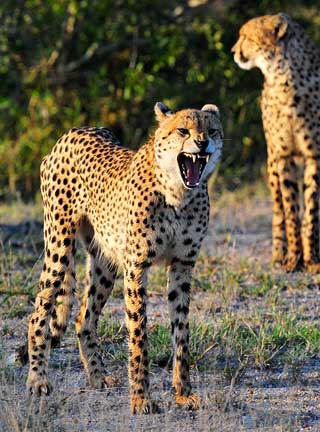
Cheetah Yawning
in the Kruger National Park
Nikon D3S with Nikon 600mm lens on Apex beanbag,
ISO 3200, f/10 @ 1/1600 sec.
A panning plate on an Apex beanbag has been found to be a better combination over a window bracket and gimbal head. If you are photographing from one of the camps then a tripod and Gimbal / ball head can be used.
The majority of cheetah activity happens during daytime, so the light tends to be bright and most cameras will therefore be suitable – you won’t need low-light capabilities.
Photographing the Cheetah’s wide open, pale gold eyes will present another challenge. The only way to achieve this is during the golden hours just after sunrise or just before sunset – the cheetah’s eyes will glow!
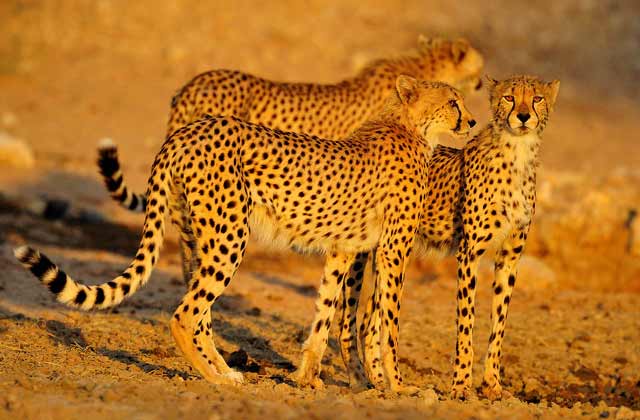
Cheetahs in Golden Light in the Kgalagadi
Nikon D3S with Nikon 600mm lens plus 1.7x tele-converter @ 1000mm on Apex beanbag, ISO 6400, f/8 @ 1/4000 sec.
Technically, cheetahs are not difficult to photograph, as the adults are large subjects.
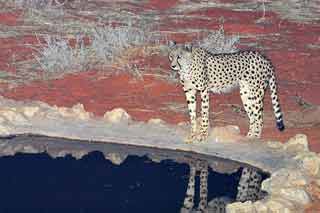
Cheetah at Kielie Krankie Waterhole
in the Kgalagadi
Nikon D3S with Nikon 600mm lens
plus 1.7x tele-converter @ 1000mm on tripod with Quantum
You may want to consider a safari camp where you can photograph subjects from the comfort and privacy of your own chalet. This includes most of the camps in the Kgalagadi, Etosha and Kruger and Pilanesberg.
A standard external flash with a Better Beamer extender can be used for most night shots. Many camps have floodlit waterholes, but for those that do not a Lightforce spotlight can be used, providing light up to 300 meters (328 yards) away.
Exposure – the black dots on the Cheetah can cause your camera to over-expose the picture, but today’s modern matrix metering tends to be accurate and you won’t need to dial in any exposure compensation. If you are creating portraits however, then you may need to underexpose to keep detail in the white muzzle.
A southern Africa photo safari adventure is one you’ll never forget!
THE PARKS:
The Kruger National Park
Location: The Park is situated in north-eastern South Africa, bordering Mozambique and Zimbabwe.
Pilanesberg National Park
Location: The Park is situated in the North-West Province of South Africa in the remains of a collapsed volcano.
Kgalagadi Transfrontier Park
Location: The Park is situated in South Africa in the Northern Cape along the Namibia and Botswana borders.
Etosha National Park
Location: The Park is situated in northern Namibia on a huge salt pan.
For more information on these four national parks, you can download a free 100-page Southern African Safari Guide when you subscribe to the Lion’s Roar Newsletter.
All text & photos: © 2013 Mario Fazekas. All rights reserved.
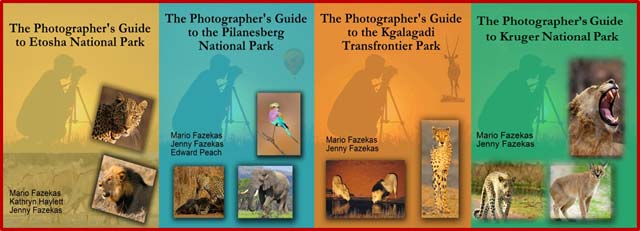
by Mario Fazekas
All text & photos: © 2013 Mario Fazekas. All rights reserved.

All these pictures taken shows a great hard work behind it. Cheetah is one of those sleek and beautiful animals that reflects some aesthetic beauty when you look at them and these images are definitely carrying that beauty. It is also a great way to let people discover about this captivating animal. I guess it will make people more conscious about why we must save these animals.